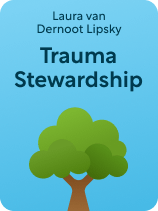

This article is an excerpt from the Shortform book guide to "Trauma Stewardship" by Laura van Dernoot Lipsky. Shortform has the world's best summaries and analyses of books you should be reading.
Like this article? Sign up for a free trial here.
What is trauma stewardship? How can secondary trauma impact a caretaker’s life?
Many people who care for people with trauma often don’t take care of themselves. This results in secondary trauma, which can be treated by practicing trauma stewardship.
Keep reading to learn more about the effects of secondary trauma, according to Trauma Stewardship by Laura van Dernoot Lipsky.
What Are Trauma Stewardship and Secondary Trauma?
What is trauma stewardship? According to Lipsky, practicing trauma stewardship means tending to your own needs and emotions so that you can fully and compassionately help others who are suffering. To practice trauma stewardship, we must recognize that trauma takes a mental, physical, and emotional toll on caregivers. Lipsky refers to this toll as your trauma exposure response, also known as secondary trauma. When you’re regularly involved with traumatic experiences, the stress and negative emotions can begin to wear on you.
If you lack a proper way to cope, secondary trauma can damage your worldview, quality of life, ability to care for others, and health. Secondary trauma can also lead you to develop emotional defense mechanisms that block your ability to empathize with and care for others. Therefore, to remain healthy, self-care is crucial for anyone who’s immersed in environments of loss, hardship, and pain—healthcare workers, animal rights activists, military personnel, people caring for ill family members, and environmentalists, to name a few.
| Why Other People’s Pain Affects Us and Tools to Recognize Secondary Trauma If you’re a caregiver, you might worry that thinking about your own needs or admitting that you’re also struggling is selfish. However, research supports Lipsky’s assertion that you must take care of yourself to give better care: Witnessing other people’s pain triggers the same parts of your brain that activate when you experience pain firsthand. Some researchers believe we have this ability to mirror other people’s emotional and physical states so we can help reduce their pain. While this allows you to empathize with other people, it also explains why being in traumatic environments for extended periods of time can erode your ability to care for others. To better recognize how your exposure to others’ trauma takes a toll on you mentally, physically, and emotionally, consider taking an assessment. Here are three tools that researchers have developed to assess secondary trauma and stress: The Secondary Traumatic Stress Scale (STSS): This consists of a list of 17 statements that you can rate on a scale of one to five, with one meaning “never” and five meaning “very often.” You can use this scale to determine how frequently you experience secondary trauma symptoms. The Professional Quality of Life (ProQOL) Measure: This tool, intended for anyone in a helping profession, measures both the positive and negative effects of your work on your quality of life. The Social Readjustment Rating Scale (SRRS): This scale contains a list of 43 common life stressors that you can identify and add up to determine how much stress you’re carrying. |
Many people who work with trauma have the opportunity to dramatically improve or worsen someone’s life. Lipsky argues that with so much on the line, you must find a healthy middle ground between numbing yourself to other people’s pain and letting it overwhelm you in order to be an effective caregiver. Addressing the effects of secondary trauma allows you to truly be present for others not just physically, but emotionally.
(Shortform note: Some experts believe that we can improve the lives of both trauma sufferers and trauma workers by teaching more workers about vicarious resilience. Vicarious resilience occurs when you grow stronger and more capable of overcoming adversity after witnessing the people, animals, or environment you’re caring for bounce back from hardship. The more trauma workers become aware of this effect, the more likely they are to experience it and give better support. This creates a positive feedback loop: Vicarious resilience leads to better caregiving and successful healing, which leads to more opportunities to develop resilience.)
How Secondary Trauma Affects Us
According to Lipsky, people react differently when exposed to others’ trauma and experience different symptoms of secondary trauma. It’s important to note, however, that secondary trauma is normal. In many lines of work, there’s a damaging belief that self-care is for the weak and that trauma workers should put on a brave face. This suppression of emotions, however, gets in the way of our ability to interact with others honestly and wholeheartedly. Instead, we must acknowledge how trauma affects us to become better listeners, advocates, and supporters.
(Shortform note: Research reveals just how normal secondary trauma is: It affects approximately 40% to 85% of professional trauma workers. So why is the belief in “toughing it out” so prevalent? According to other experts, some organizations perpetuate this harmful belief by praising self-sacrificial behavior, such as when workers refuse to take time off. The expectation of self-sacrifice pressures employees to work harder at the expense of their well-being. Many argue that it should be the organization’s responsibility to reduce workers’ feelings of guilt about self-care, not to intensify them.)
Lipsky writes that three factors influence how we’re exposed to and impacted by the trauma of others:
Individual experiences: Your personal history of pain and suffering can affect how you view other people’s hardships, making you more sensitive to some people’s trauma than others. Lipsky stresses that you must learn to view your own traumas as separate from that of others to work with them in a way that’s healthy and effective.
(Shortform note: In The Power of Now, Eckhart Tolle refers to your history of pain and suffering as your pain-body: The negative energy you carry from all of your painful life experiences. Anything can trigger your pain-body, causing you to feel negative emotions like irritation, anger, or sadness. If you let these emotions control your thoughts, they make you act in unhealthy ways that only deepen your pain, perpetuating a cycle of hurt that affects yourself or others. To free yourself from your past pain, Tolle suggests you observe it without judgment. This helps you recognize that your former pain doesn’t have power over how you feel and behave.)
Workplace environments: Trauma workers’ environments can increase or decrease how much other people’s trauma affects them. A negative work environment worsens the effects of trauma exposure while a positive environment diminishes them. According to Lipsky, many trauma workers lack the support they need to do their best work, whether it’s a lack of resources or an unreasonable workload. As a result, many have to budget their time and energy and settle for providing minimally adequate care, which Lipsky describes as “service rationing.” This leaves workers feeling tired, unfulfilled, and discouraged.
(Shortform note: Some experts suggest that organizations can further mitigate the effects of trauma exposure on workers by reducing the amount and severity of trauma they’re exposed to. One way of doing this is having workers alternate between two different types of tasks—the more emotionally-draining tasks and the more emotionally-rewarding tasks. For example, an animal rescuer could take time to socialize and play with the animals in between responding and saving abused animals.)
Systemic oppression: Lipsky argues that systemic oppression in our society, or the mistreatment of certain groups as a result of flawed institutions and beliefs, both causes some people to be more susceptible to trauma and hinders our ability to combat trauma. First, since we don’t live in a society of pure equality and justice, certain groups experience trauma more than others. Second, many people share a wider oppressive belief that care is a burden to society, that people should worry about their own lives, and that people get what they deserve. Lipsky argues that this perception of care makes trauma workers feel less supported and receive less support.
(Shortform note: Other experts add that the fact that certain groups are more at risk for trauma than others should influence how trauma workers care for people with different backgrounds. Rather than assume a person’s needs, recognize that people may communicate differently about them or expect different methods of care. Different cultures also have different attitudes toward caregiving that affect how much support caregivers receive. For instance, in Latin America, caregiving for family members is typically seen as virtuous, and the—mostly female—population of caregivers can be a source of cultural pride.)

———End of Preview———
Like what you just read? Read the rest of the world's best book summary and analysis of Laura van Dernoot Lipsky's "Trauma Stewardship" at Shortform.
Here's what you'll find in our full Trauma Stewardship summary:
- That the best way to care for others is to care for yourself
- How trauma damages the caregivers who are exposed to others' trauma
- How caregivers can manage secondary trauma to better support others






